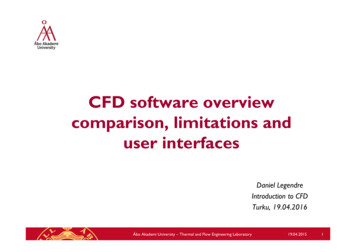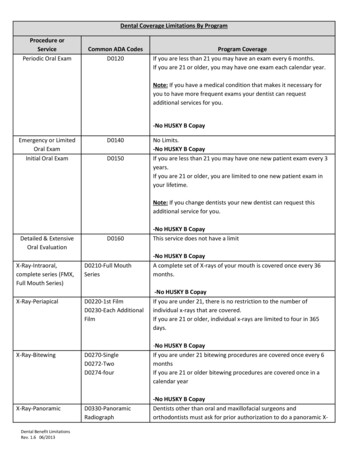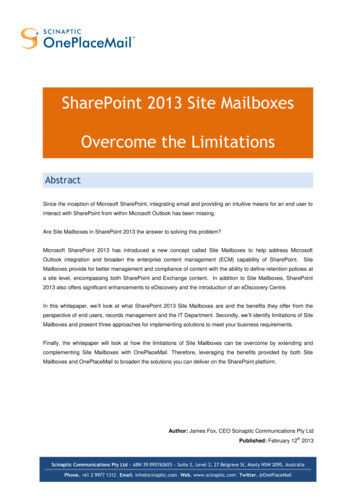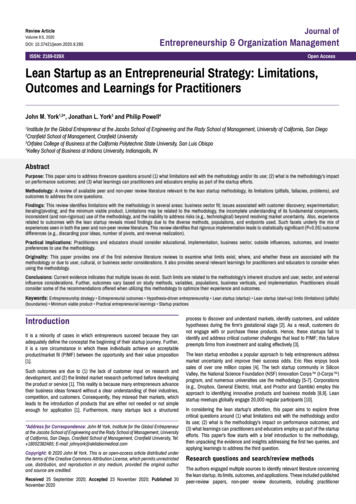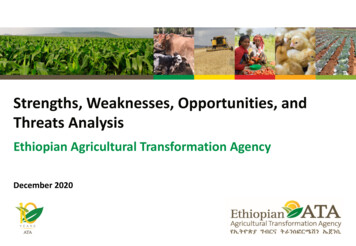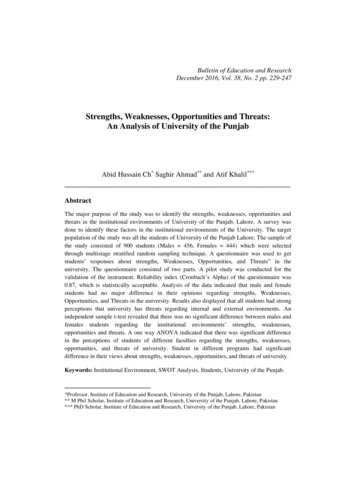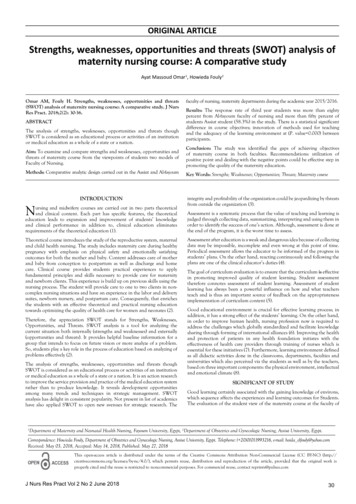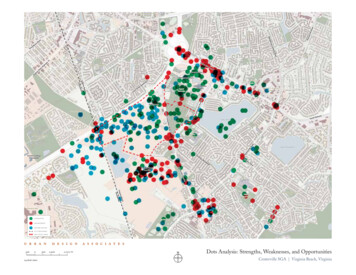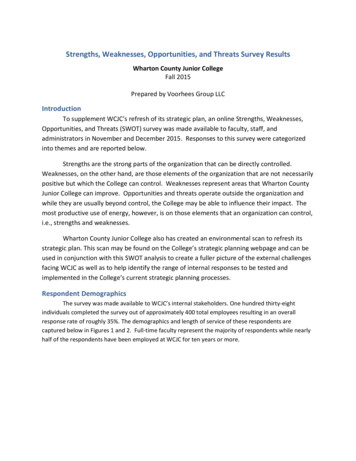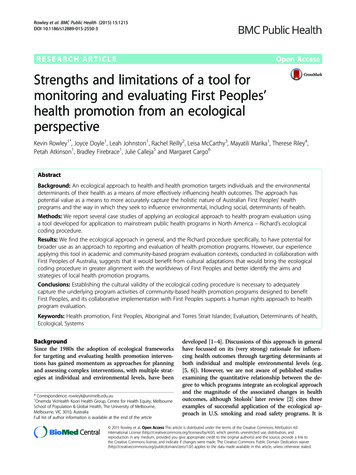
Transcription
Rowley et al. BMC Public Health (2015) 15:1215DOI 10.1186/s12889-015-2550-3RESEARCH ARTICLEOpen AccessStrengths and limitations of a tool formonitoring and evaluating First Peoples’health promotion from an ecologicalperspectiveKevin Rowley1*, Joyce Doyle1, Leah Johnston1, Rachel Reilly2, Leisa McCarthy3, Mayatili Marika1, Therese Riley4,Petah Atkinson1, Bradley Firebrace1, Julie Calleja5 and Margaret Cargo6AbstractBackground: An ecological approach to health and health promotion targets individuals and the environmentaldeterminants of their health as a means of more effectively influencing health outcomes. The approach haspotential value as a means to more accurately capture the holistic nature of Australian First Peoples’ healthprograms and the way in which they seek to influence environmental, including social, determinants of health.Methods: We report several case studies of applying an ecological approach to health program evaluation usinga tool developed for application to mainstream public health programs in North America – Richard’s ecologicalcoding procedure.Results: We find the ecological approach in general, and the Richard procedure specifically, to have potential forbroader use as an approach to reporting and evaluation of health promotion programs. However, our experienceapplying this tool in academic and community-based program evaluation contexts, conducted in collaboration withFirst Peoples of Australia, suggests that it would benefit from cultural adaptations that would bring the ecologicalcoding procedure in greater alignment with the worldviews of First Peoples and better identify the aims andstrategies of local health promotion programs.Conclusions: Establishing the cultural validity of the ecological coding procedure is necessary to adequatelycapture the underlying program activities of community-based health promotion programs designed to benefitFirst Peoples, and its collaborative implementation with First Peoples supports a human rights approach to healthprogram evaluation.Keywords: Health promotion, First Peoples, Aboriginal and Torres Strait Islander, Evaluation, Determinants of health,Ecological, SystemsBackgroundSince the 1980s the adoption of ecological frameworksfor targeting and evaluating health promotion interventions has gained momentum as approaches for planningand assessing complex interventions, with multiple strategies at individual and environmental levels, have been* Correspondence: rowleyk@unimelb.edu.au1Onemda VicHealth Koori Health Group, Centre for Health Equity, MelbourneSchool of Population & Global Health, The University of Melbourne,Melbourne, VIC 3010, AustraliaFull list of author information is available at the end of the articledeveloped [1–4]. Discussions of this approach in generalhave focussed on its (very strong) rationale for influencing health outcomes through targeting determinants atboth individual and multiple environmental levels (e.g.[5, 6]). However, we are not aware of published studiesexamining the quantitative relationship between the degree to which programs integrate an ecological approachand the magnitude of the associated changes in healthoutcomes, although Stokols’ later review [2] cites threeexamples of successful application of the ecological approach in U.S. smoking and road safety programs. It is 2015 Rowley et al. Open Access This article is distributed under the terms of the Creative Commons Attribution 4.0International License (http://creativecommons.org/licenses/by/4.0/), which permits unrestricted use, distribution, andreproduction in any medium, provided you give appropriate credit to the original author(s) and the source, provide a link tothe Creative Commons license, and indicate if changes were made. The Creative Commons Public Domain Dedication o/1.0/) applies to the data made available in this article, unless otherwise stated.
Rowley et al. BMC Public Health (2015) 15:1215also clear that smoking prevalence in Australia hasresponded to multi-level intervention at a national level [7].An ecological approach thus allows assessment of howhealth programs address the ‘social determinants ofhealth’. Social determinants are conventionally taken tomean employment, income, education, housing and otherindicators related to Western cultural norms. From a FirstPeoples’ perspective, social determinants can include amuch broader array of influences including cultural genocide and survival, Land, family support and connection,relationships with mainstream/dominant society and FirstPeoples’control over their own health, and it also encompasses issues of Human Rights and health equity [8–10].Hence the application of such an approach (or any otherapproach) must be at the direction of First Peoples inorder to meet standards of rigour in data collection andinterpretation and to meet human rights obligations regarding First Peoples’ access to information about theirown health [11]. In this paper we have used a definition ofsocial determinants that encompasses this breadth of influences identified by First Peoples, and incorporated theassociated processes of leadership by and collaborationwith First Peoples.Internationally, the evaluation of health programs hasbeen problematic in the absence of local community input and control over what is monitored and how, whatdata mean and what constitutes ‘success’, and the needto overcome a dominant postpositivist approach that ignores important contextual factors such as social determinants [12]. Likewise in Australia, there is a gap inknowledge on how to evaluate the extent to whichhealth promotion activities address determinants of FirstPeoples’ health. Ecological theory recognises the influence of the social and physical environment on wellbeing, and an ecological approach to health promotionis more aligned with the holistic, ‘whole of community’approach favoured by Aboriginal Community ControlledOrganisations (ACCOs) and with current frameworksand policies [13, 14]. As such, it has the potential to atleast partly meet the identified need to develop methodsthat come closer to measuring the impact of interventions, which are often complex and multifaceted [15].Ecological theory provides a lens for understanding anddescribing the multi-level nature of communities, withinteractions between the social, physical and policy systems in which people live. It is in this context that wehave investigated methods for capturing the purpose anddesign of health programs which seek to address FirstPeoples’ health in Australia.In the Aboriginal and Torres Strait Islander health research literature an ecological approach appears explicitly in an increasing number of reports, including: alongitudinal evaluation of health initiatives at a remotecommunity in the NT [16]; the Audit and Best PracticePage 2 of 9in Chronic Disease (ABCD) project in the primaryhealth care setting where certain ecological elements areincorporated into health promotion audit activities [17];a recent literature review that discussed physical activityfor First Peoples in a social ecological context [18]; andfamily wellbeing empowerment programs [19]. We havealso identified such an approach in research reports ofseveral other programs [20]. Given an increasing focuson the social and other environmental determinants ofhealth in research and policy development for First Peoples in Australia, tools that provide a systematic way ofevaluating the extent to which programs integrate anecological approach are of potential value. This paperdescribes our experience of using one such tool in evaluating First Peoples’ health promotion programs andhighlights the challenges and limitations in applying anecological approach derived from a Eurocentric worldview in this context.MethodsResearch context in which an ecological approach wasadopted for the evaluation of First Peoples’ healthprogramsOver the course of investigating community-based healthprogram implementation with various community, nongovernment and academic organisations, several issueshad arisen repeatedly in our experience. Firstly, routinereporting to program funders does not capture the depth,complexity and aims of First Peoples’ health initiatives;and secondly, there are few tools for systematically recording these aspects of health programs. These issues are alsoreflected in published research on First Peoples’ health,much of which has traditionally had a narrow biomedicalfocus [8, 20], and are not restricted to Australia [12]. Theinformation presented here is effectively a case study ofour attempts to use a tool designed for mainstream publichealth programs in Canada [4, 21] as a means to addressthese common issues. The ecological coding procedurewas chosen because it has been applied in First Peoplescommunities previously [16, 22]. It is one of the few, if notonly, tools that has the capacity to operationalise the extent to which programs are ecological and account for thesocial determinants of health in health programming.The national research agenda of the Co-operative ResearchCentre for Aboriginal HealthFrom around 2002, the Co-operative Research Centrefor Aboriginal Health (CRCAH) was establishing itsChronic Conditions Program of applied research at a national level. In part responding to outcomes of a health industry roundtable, the CRCAH’s agenda prioritised projectsaddressing chronic disease management approaches thatinvolved families, organisations and communities [23]. TheCRCAH 2007 publication Beyond Bandaids included a
Rowley et al. BMC Public Health (2015) 15:1215review of interventions that took a community development and empowerment approach to addressing the socialdeterminants of health. The review took a broader view ofwhat constitutes ‘social determinants’ than the Eurocentricdefinition in common use at the time, and identified a needfor “methodologies capable of assessing and explainingcommunity development and empowerment processes andoutcomes” [24]. Like other work [12], the review noted theimportance of a transdisciplinary approach to program design and evaluation and the need to involve industry partners to maximise the likelihood of research translation topractice.The successor to the CRCAH, the Co-operative ResearchCentre for Aboriginal and Torres Strait Islander Health(subsequently renamed the Lowitja Institute) further developed this work though its Healthy Communities andSettings Program which took an overtly ecological approach to researching health program design and evaluation and had as its goal “An improved understandingof the determinants of Aboriginal and Torres StraitIslander health through the development and use oftools that more accurately measure enabling environments to improve the health and wellbeing of Australia’sFirst Peoples” [25]. The program included research investigating racism as a social determinant of First Peoples’ health and the implementation and evaluation ofmulti-level interventions in mainstream institutions toprevent racism [26, 27]. As an applied research program, expected outcomes included: better integrationbetween addressing the clinical and social determinantsof health; a framework, tools and capacity building forcommunity organisations to monitor, evaluate and report on their programs, and develop health promotionservices; meeting the challenge of attributing outcomesto programs in a context of multiple programs andstakeholders operating in community at any one time;and empowering communities to take a ‘bird’s eye view’of program activities to inform local decision-making.Developing a local research program to evaluate FirstPeoples’ health promotionIn parallel with the development of this national agenda,the development of a research program with ACCOs innorthern Victoria over a number of years led us to tryand address the barriers noted above to ongoing supportfor Aboriginal health promotion. Commencing in 2001as a risk factor screening development program, TheHeart Health Project evolved to also include investigationof determinants of wellbeing, development and evaluationof nutrition and physical activity programs for youth, andthe establishment of a cross-organisational alliance forhealth promotion implementation and its evaluation usingan ecological approach [9, 28–30]. It was also at this timethat The University of Melbourne Department of RuralPage 3 of 9Health was being established in Shepparton in partnershipwith Rumbalara Football Netball Club, and the Universitystarted to engage with the community more broadlythrough the Koori Health Partnership Committee [31].The Creating Healthy Environments project which evolvedfrom these collaborations takes an overtly ecological approach to program evaluation as a means to a) better capture the design complexity of First Peoples’ healthpromotion, and b) develop feasible tools and processes toallow health promotion practitioners to better monitor,evaluate and report their activity. We hypothesised that across-organisational partnership would allow a more ecological – and thus more effective – approach to healthpromotion by drawing on the breadth of expertise andresources available to diverse organisations. The projectwas approved by The University of Melbourne’s HumanResearch Ethics Committee. The research process –oversight and decision making by a local Steering Committee representing the partner organisations, inclusion ofcommunity researchers as Co-Investigators, capacity exchange, privilege given to local interpretation of researchdata, co-authorship of research articles – reflect currentethical guidelines [32] and a rights-based approach to FirstPeoples’ health.The collaborating community organisations have stronghistorical, cultural and social connections. They have beenrepresented by community leaders on a project SteeringCommittee with The University of Melbourne from theoutset. Building on earlier work in the region [31], a seriesof Memoranda of Understanding set out the principles ofthe working relationship between these organisations andthe University, and explicitly place ultimate control of theresearch design, conduct and reporting in the hands of theparticipating ACCOs [28]. The Memorandum of Understanding is not a legally binding document however, theUniversity has standard requirements relating to intellectual property which are acquisitive and obscured in legaljargon, and there are issues of First Peoples’ knowledge,intellectual property and culture that are not part ofstandard agreements. Hence some negotiation was required to meet ethical guidelines relating to First Peoples’health research [32] and for consistency with principles ofcommunity control.Working collaborativelyImplementing and evaluating an ecological approach tohealth promotion will most often require a crossorganisational, collaborative approach in order to effectively address the determinants of health. Working inpartnership should, in theory, allow greater consistencywith an ecological approach – the expertise, reach andresources of multiple organisations should allow moresettings, targets and strategies to be incorporated intoprograms. However, particularly from a research
Rowley et al. BMC Public Health (2015) 15:1215Page 4 of 9perspective, there are clearly historical barriers forcommunity collaborating with mainstream institutions.Issues of trust, capacity in both mainstream andACCO sectors to engage, and the presence of resourcesand authority for working across institutions can all impact on the implementation of strategies for working inpartnership. Community workers are subject to the pressures of time constraints, workload, organisationalaccountability, standard reporting requirements, localcommunity issues, and other competing priorities. Inaddition, there remains a lack of appreciation for the aimsand purpose of health promotion and its associated activities as implemented by First Peoples and organisations.Trust is as important when conducting community-basedparticipatory action research with health promotionpractitioners as it is in academic work that seeks toincorporate Indigenous knowledge. For the projectsdescribed here, our working groups consisted of Universityand community-based researchers involved in CreatingHealthy Environments, along with Aboriginal and TorresStrait Islander collaborators recruited for their specific localor regional expertise in health or health promotion. Thelong term working relationships between a majority of theworking group members enabled a generally safe workingenvironment to be established, in which diverse views couldbe presented and disagreement accommodated. In practice,project implementation relies on trust, which is onlyachieved through the development of good working relationships at a personal level between researchers and community representatives.The discussion below is based on our experience ofapplying an ecological approach to evaluating these andother community-based health promotion activities inVictoria, and in a literature review and characterisationof First Peoples’ health programs that included environmental targets [20].A tool for monitoring program activity implementationIn 1996, Richard and colleagues published an analyticalmethod for assessing the degree to which health promotion programs integrate an ecological approach. Basedon the earlier work of McLeroy [1] and Simons-Morton[33], and drawing on systems theory [34–36], a methodwas developed that identified both the targets of a healthpromotion activity and the setting from which the participants are drawn [21]. It was designed to assess theextent to which ecological principles were integrated inhealth promotion programs in public health units inCanada [21, 37] by capturing information on specific activities implemented as part of a health promotion program. Richard’s bi-dimensional ecological approach buildson McLeroy’s single-dimensional ecological frameworkfeaturing intervention targets, the bidimensional typologyunderpinning Multilevel Approaches Toward CommunityHealth [33] and the Precede/Proceed planning and evaluation model [38]. Thus interventions are coded on a gridaccording to two dimensions - the setting and the intervention target (Fig. 1). The higher categories of Miller’sLiving Systems Theory [36] are used as settings for ecological analysis: organisations, communities,1 societies and‘supranational systems’ (two or more countries). Settingsrefer to the places in which participants are reached orrecruited into the activity and not the location where theactivity is implemented. A health promotion program mayreach or recruit participants in one or more of these settings. Within each setting, a number of targets are possible: the individual; the interpersonal environment; theorganisation; the community; or political targets. Thesetargets also can be networked to reflect the formation ofcommunity coalitions, collective governance structures,social support groups, mutual aid and other forms of social and family collectives.According to Richard [21], an ecological program includes activities aimed at both environmental and individual targets and delivers these activities in a variety ofsettings. Richard, following Stokols [39], considers thedegree to which a program integrates the ecological approach as a function of targets and settings: the more aprogram integrates individual and environmental targetsacross a range of settings, the more ecological it is. Inaddition, for a program to be ecological it must includea minimum of two intervention strategies: one with theclient as a direct target and one strategy directed towards an environmental target. Finally, Richard’s ecological approach gives greater weight to the number oftargets than to the number of settings in the program.The utility of this ecological coding procedure is that itdistinguishes traditional health education strategies fromSettings from which t
Strengths and limitations of a tool for monitoring and evaluating First Peoples’ . Rowley et al. BMC Public Health (2015) 15:1215 Page 2 of 9. review of interventions that took a community develop-ment and empowerment approach to addressi
